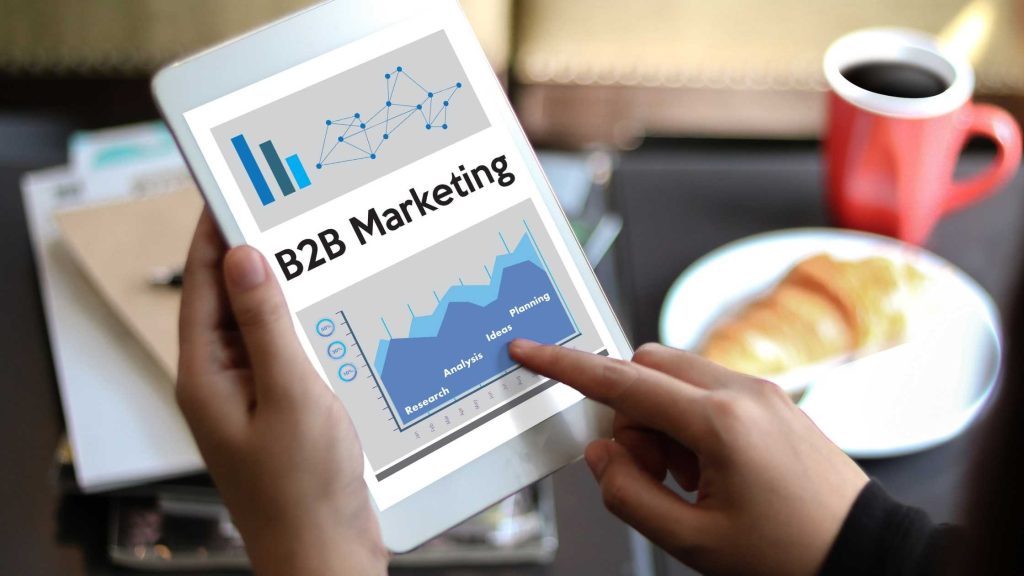Introduction
B2B Integrated Marketing is not a fad; it is a deliberate approach to align your brand tone. Such as visuals, message, and the people, processes, and technology involved in delivering it, across every channel your buyers meet it. Because in a reality where the average pro encounters around 30 touchpoints daily, consistency matters.
Without a clear plan, your messages will look messy. People will get confused and stop trusting your brand. However, when everything in the marketing strategy works together, it feels trustworthy. Each part helps buyers move forward without slowing down.
Whatever the medium, the user should get the same clear message and feeling. That’s what makes Integrated Marketing powerful: it helps people follow one smooth path from learning about you to taking action.
Want to make sure every word your brand says works together? Let’s get started.
7 steps to create a powerful B2B integrated marketing campaign
Step 1: Set Clear Business and Marketing Goals
One of the cornerstones of being a successful B2B integrated marketing company is to ensure all teams are moving forward in the same direction. When everyone is doing something else, your message gets lost. Just like marketing could be focused on acquiring new leads, while sales tries to retain old customers, which is not aligned.
Begin by asking: What do we want this campaign to accomplish? Are we trying to create brand-new leads? Sell more to current customers? Get our name ID up? Keep our clients happy.
Once that’s clear, everyone, from marketing and sales to product and customer support, should agree on the same goals before anything begins.
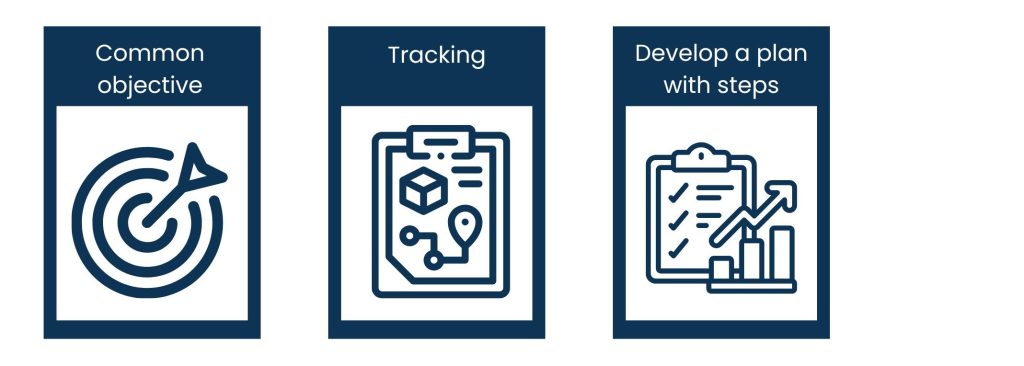
What to Focus On:
- Common objective: Ensure that the team knows what the primary goal is, and everyone is on the same page.
- Tracking: Track it in specific numbers, such as open rate of emails, number of clicks, or sign-ups, so you can see what’s working.
- Develop a plan with steps: Break your campaign into little pieces like getting noticed, helping people decide, and making a sale. Understand what success looks like at all levels.
When everyone knows what they are aiming for and works toward that goal together, then your B2B Integrated Marketing gets much stronger. Every message, email, and post works like part of the same story, pulling in the same direction to get real results.
Step 2: Know your B2B audience for B2B Integrated Marketing
You’re working in a business-to-business capacity, so you need to know who you’re speaking to.
You’ll want to have a sense of who it is you’re addressing before you start distributing the message. In B2B integrated marketing, this is understanding more than someone’s job title. You want to understand what kind of work they’re doing, what kind of problems they face, and how they decide to buy something.
Just don’t guess, use real data. Speak with members of your sales team, review your website data, examine feedback from past customers, and leverage your CRM solutions. You use this to construct a detailed image of your ideal customer, which is often referred to as a buyer persona.
Once you understand your audience, it’s far easier to speak to them in a way that is human and useful, regardless of where they come into contact with your message.

What to Focus On:
- Speak their language: If your buyer wants to refer to the thing you’re selling as a ‘solution’ instead of a ‘product,’ you get to, so speak the language that they are used to speaking.
- Learn who they are: Find out their company/title.
- Know what they’re up against: What are they facing, and what could you do to help?
- You should think about how they like to consume information: are they video, they are text?
- Know the reason for their transitioning: Understand why they chose to buy the new software.
When your audience receives the same message, it will seem much more real and relevant. They’ll believe your text and be ready to move on further.
Step 3: One Powerful Message That Works Everywhere for B2B Integrated Marketing
For your B2B marketing to break through, you need one clear message that articulates to people why your product or service is meaningful. What you want that message to be is simple: that you can use it wherever, in an ad, in an email, in a blog, in a sales call.
You can think of it as a story’s headline; however, you reshuffle the pieces, and the story remains the same. It should address any big questions your audience has and demonstrate how you can help.
Instead of making lots of different messages for each platform, create one strong core message that you can adjust a little depending on where you’re using it.
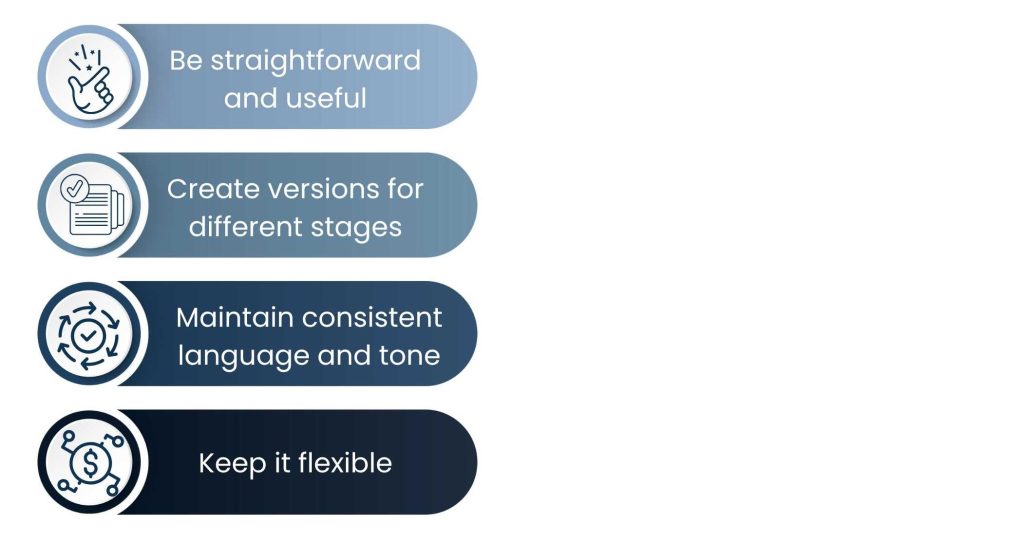
What to Do:
- Be straightforward and useful: This is not the time to simply describe your product. Show people how it helps them toward their goal or to solve a problem.
- Create versions for different stages: Those at the top of the journey need a different message than those about to buy. But same basic principle, adapted to where they are, such as “just learning,” “thinking about it,” or “ready to decide.
- Maintain consistent language and tone: Keep your brand identity throughout all communication.
- Keep it flexible: You can make it short for headlines or long for presentations; it should fit anywhere.
That core message will play out clearly in everything you do in your marketing communications, which will serve to make your marketing communications feel consistent and further solidify your value in their mind at every touchpoint. This reliability instills confidence, boosts awareness, and enables more effective results for each campaign piece.
Step 4: Be Smart About Which Channels to Choose For B2B Integrated Marketing
A mistake many people make in integrated marketing is trying to be all things to all people. But, for B2B audiences, it is not about the number of channels – it is about selecting the platforms where your buyers are most active and engaged. The right platform increases your returns by spending on marketing.
Start with your personas: Where do they hang out? What platforms do they trust? Then address the channels that make sense to the interests of your prospect and the stage of the buyer journey that they’re in.
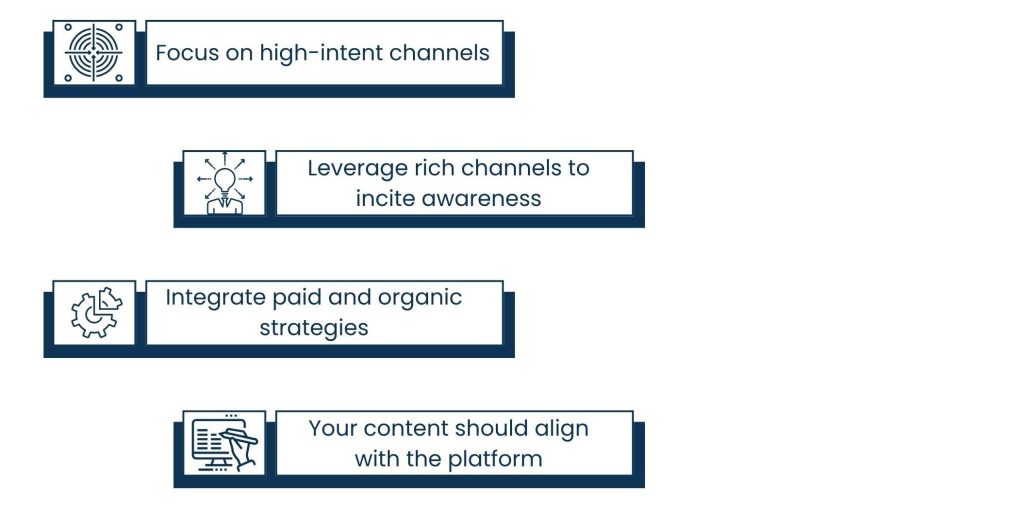
Key actions:
- Focus on high-intent channels: Leverage Google Ads, LinkedIn, and email to promote content designed for the decision stage.
- Leverage rich channels to incite awareness: Webinars, blog posts, social media, it’s all top-of-the-funnel activity.
- Integrate paid and organic strategies: Grow organically and with paid ads to enhance the results.
- Your content should align with the platform: Spread images with text on LinkedIn, downloadable guides in email, and how-to blogs on the site.
And, by using the optimum assortment of highly focused media, your B2B Integrated Marketing strategy also becomes much more powerful, offering a single, strong message wherever it will do the most good for your targeted prospect.
Also Read: Mastering Voice Search Optimization
Step 5: Get Internal Teams Aligned on Same Campaign Calendar
Internal misalignment is the enemy of an effective B2B Integrated Marketing approach. If your marketing, sales, design, and content people are all working in a bubble, that loud external messaging is going to seem disjointed. That’s why a shared campaign calendar approach is essential.
It’s when everyone is working off the same calendar and strategy, so that social posts to sales outreach support that same message at the same time.
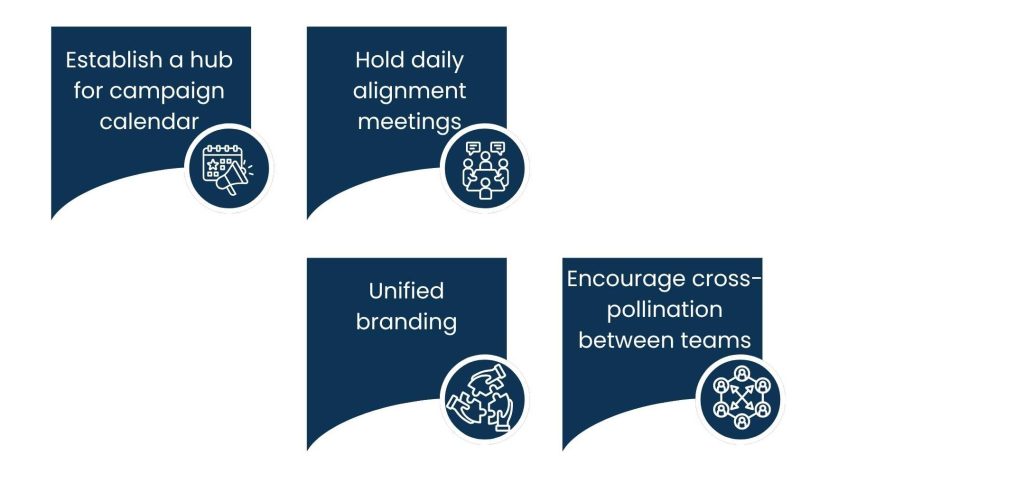
Key actions:
- Establish a hub for campaign calendar: Incorporate launches, content drops, ad campaigns, and key events.
- Hold daily alignment meetings: Ensure each department knows exactly what’s launching, when, and why.
- Unified branding: All channels send the same message, strengthening the message of your marketing across all the touchpoints your customers engage in.
- Encourage cross-pollination between teams: Allow the sales department to have marketing support in follow-up materials.
With internal alignment, your marketing communications are more focused and less fragmented, so they’re more effective.
Step 6: Get Started with Cross-Channel Synchronization While B2B Integrated Marketing
A successful integrated marketing campaign is not so much about having terrific content as it is about releasing every component all at the same time. Because that email campaign, social ads, blog content, and sales outreach all land at once with the same message, it creates irresistible momentum.
Cross-channel querying exists, so that wherever your audience interfaces, LinkedIn, inbox, site, or search, you’re reinforcing the same message with the same value prop.

Key actions:
- Schedule content to launch simultaneously: Post all your content at the same time and align it around the core of your message.
- Leverage email and sales outreach to help support launches: Keep the campaign going with email marketing and sales enablement materials.
- Match CTA alignment between assets: The person who lands on a post-click page should see the same offer and messaging, the one they clicked on in the first place.
- Landing Page: Build a home landing experience to send all traffic to a beautifully crafted campaign-specific landing page.
This is that the levels of B2B Integrated Marketing coordination it offers all conspire to make your strategy invisible to prospects, in effect, helping you use momentum to not only drive more engagement and awareness but also to drive conversions through each touch point.
Step 7: Continuous Monitoring and Refining for B2B Integrated Marketing
Chap 16 A/B2B IM, why even the best laid and executed B2B IM will constantly need attention. You can also track your campaign’s performance to see what’s working, what’s not working, and what to alter; it’s feedback in real-time.
Your analysts need to go beyond vanity numbers like impressions or clicks and focus on what leads to pipeline growth, qualified leads, and conversion rates. Use those insights to maximize your effectiveness: to adjust your messaging, to reallocate your budget, to play your timing.

Key actions:
- Monitor KPIs at the channel level: Watch for engagement and conversion rates.
- Centralized dashboards: Aggregated dashboards with tools like HubSpot, Salesforce, or Google Data Studio can be another tactic to aggregate campaign data in a centralized truth.
- Segmented results by persona or stage: Discover which segments perform best in terms of engagement and which stage in the buyer journey they are in.
- Optimize, A/B test like hell: Use performance data to edit subject lines, headlines, photos, CTA, and so on.
This data-driven marketing campaign approach to data ensures your integrated marketing campaign is agile, enabling you to iterate what’s working and what’s not, without the necessity of starting over.
How B2B Integrated Marketing Supports The Full Funnel?
Funnel management is defined by the content types, content distribution, and content engagement.
There is perhaps no greater benefit that comes from B2B Integrated Marketing to facilitate the entire buyer journey, from Awareness to Decision. Rather than taking a piecemeal approach, where each touchpoint is treated as a siloed activity, integrated marketing truly aligns everything, cementing the idea that each asset, message, and meeting is a necessary step in convincing your prospect to make the best decision.

Here’s how the integration makes every step of the funnel stronger:
1. Awareness Stage: Creating visibility and awareness
- Keep brand messaging consistent across social media ads, organic posts, and blogs that are optimized for SEO.
- Teach, don’t pitch, concentrate on issues, challenges, or trends that matter to your audience.
- Plant the seed of future interest by explaining your unique value proposition.
2. Consideration: Generating Interest and Trust
- Email nurture sequences must be consistent with blog and landing page copy.
- Webinars, guides, or whitepapers demonstrating knowledge – positioning you as an ‘of course you’re a solution for me’ brand.
- What the prospect is hearing (mutual messaging on both outreach and the posted content) in both outreach and the posted content is read.
3. Decision Stage: Converting with Confidence
- The proof of success and the removal of any questions are in case studies, testimonials, and even example-type ROI calculators.
- Enablement content needs to map to previous touchpoints to avoid conflicting or disconnected messages.
- Retargeting advertisements should mirror the offers and content available from discussions in nurture flows or landing pages.
When your funnel is combined, the journey for a buyer seems like one smooth flow. Every touchpoint is considered a follow-up from the last. This is not only trust-building but also shortens the decision cycle, a huge bonus in B2B where deals can go on for weeks or even months. Integration isn’t just efficiency. It’s conversion-focused clarity.
Also Read: Marketing Assistant Duties for Remote Work
Aligning Content Strategy with Integrated Campaign Objectives
For a B2B Integrated Marketing strategy to work, your content strategy must be very closely attuned to the needs and expectations of your target audience about the campaign goals. Content is not just filler; it is the fuel that keeps every step of the funnel running and that provides value and decision-making that the funnel flows towards.
The best integrated campaigns treat every piece of content as a related asset, not a standalone item. That means blog posts, videos, case studies, and landing pages all speak the same language, address the same personas, and have a clear campaign reason for being.

1. Begin with Campaign Objectives and Personas
- Clearly outline each content asset: lead generation, nurturing, upselling, etc.
- Map every content asset to a buyer persona: type of industry, role, or problem-opportunity.
- Make certain that every asset plays a role in the same story: from the top to the bottom of the funnel.
2. Align Content Formats with Funnel Stages
- Awareness stage: Blogs, infographics, social snippets, and videos that provide a peek into problems and trends.
- Consideration: Ebooks, comparison guides, webinars talking about their problem, etc, and email sequences to teach and nurture.
- Decision stage: Case studies, testimonials, pricing pages, one-pagers to seal the deal.
3. Create Cohesion Across Platforms
- Repurpose long-form content (a whitepaper, for example) into email series, social posts, and little video clips.
- Maintain the identical look and language: Create brand recognition and strengthen trust with the same visual identity and tone.
- Send all traffic to planned landing pages that were made with the same campaign in mind and the same CTAs.
When your content acts in concert under a campaign mandate, it enhances your message and moves your prospects along more efficiently. That’s the essence of a well-executed integrated marketing communications strategy: purposeful, effortless, and designed to make a statement.
Conclusion: The Aftermath and Making Your Message Scalable for B2B Growth
A strong B2B Integrated Marketing strategy links your message, channels, and people together to create one campaign engine. It means every email, ad, blog post, or conversation point our customers toward a solid, engaging story. No matter what stage of the funnel they enter.
Goal setting, audience research, synchronized execution, and performance analysis all work together. To create that seamless experience that reinforces brand trust and has a positive impact on ROI. With good IMC, you’re not broadcasting, you’re broadcasting with a little bit of a leading-rein action.
In a cluttered B2B playing field, simplicity for the win. Integration is how you provide that clarity at scale, across teams, and through the buyer journey.
About Us
Tasks Expert offers top-tier virtual assistant services from highly skilled professionals based in India. Our VAs handle a wide range of tasks, from part time personal assistant to specialized services like remote it support services, professional bookkeeping service etc. Furthermore, it helps businesses worldwide streamline operations and boost productivity.
Ready to elevate your business? Book a Call and let Tasks Expert take care of the rest.





